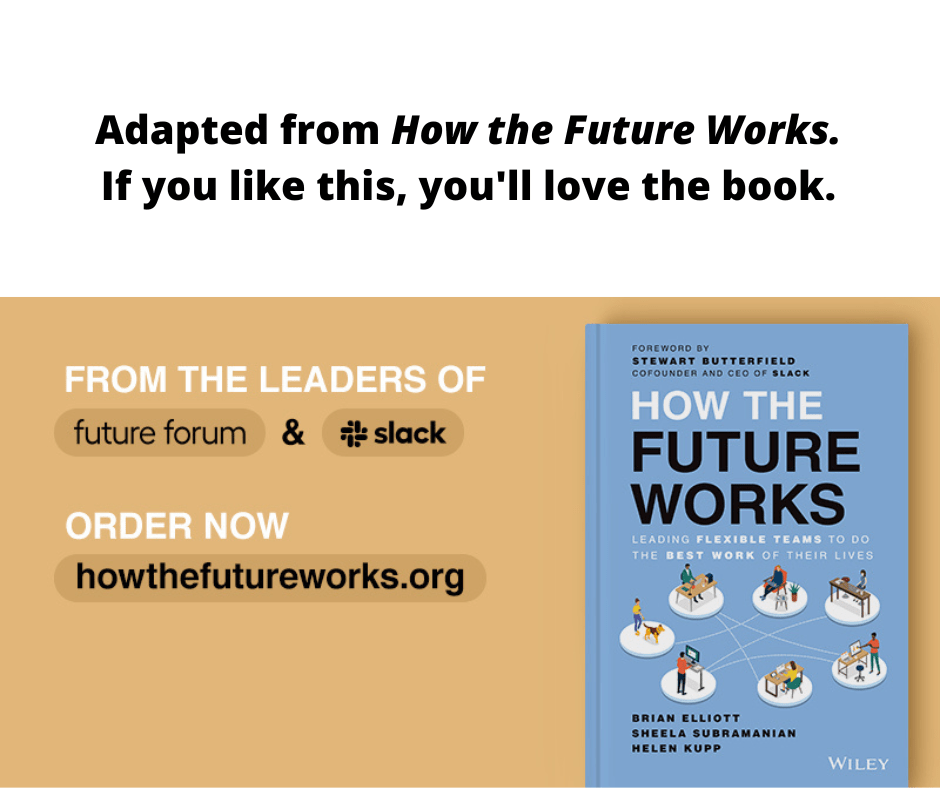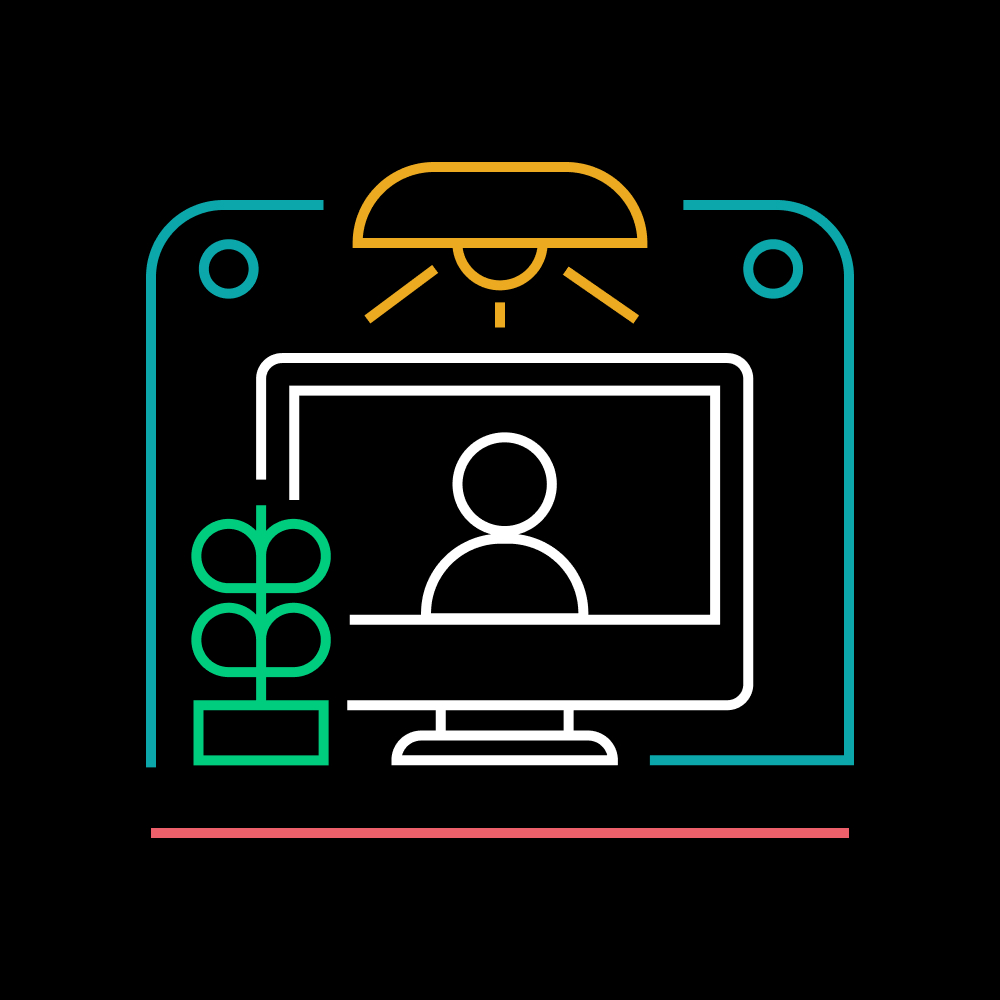
How to prepare your organization to experiment with flexible work
Finding your footing with flexible work is an iterative process. Here’s how to normalize a culture of learning and experimentation.
Posted June 10, 2022 by Eliza Sarasohn
After the pandemic hit, many executives were focused on getting people back into the office as soon as possible — despite all the evidence showing that most companies had been quite successful working more flexibly.
When we asked them why they wanted employees back in the office, the answers we heard often came down to two things: fear and habit.
“There’s a lot of fear of the unknown — fear that the culture they came up in will ‘degrade,’” explained one executive, echoing a concern we heard repeated time and time again. “There’s also an underlying presumption that the past was good when it wasn’t uniformly.”
While the traditional office-centric culture may have suited a select few in the C-suite, research shows it did not meet the needs of the majority of employees. But how do you make the monumental transition to flexible work when some people — particularly those in decision-making positions — were happy with how things were before?
The tough truth is, once you’ve laid the foundation for your flexible work transformation — by establishing your principles, your guardrails, and your team-level agreements — you’re in new territory. There’s no single flexible work blueprint that works for every organization and team, and determining which changes to implement at your organization while also doing the work required to shift people’s beliefs and behaviors can feel like an incredibly daunting undertaking.
A change this big certainly won’t happen all at once. And not everything is going to work perfectly from the start. That means you need to prepare yourself — and your organization — for a process of experimenting, learning, and making adjustments in both behavior and thinking.
This playbook is for leaders who want to
- Build momentum and support for a flexible work transformation
- Normalize a culture of experimentation and learning
- Develop the communication streams and feedback loops to bring people along every step of the way
Enlist your early champions as change advocates
In designing your flexible work plans, it’s absolutely essential to involve people from all areas and levels of your organization. Unfortunately, research shows that most leaders fall down on this step; more than 60% of executives in our Future Forum Pulse survey said they designed their companies’ post-pandemic workforce policies with little to no direct input from employees. And while 66% of executives believe they’re being “very transparent”’ with regard to their post-pandemic remote working policy, only 42% of workers agree.
Soliciting ongoing input from all levels of your organization requires putting a dedicated structure in place. Start by forming a task force made up of a diverse and representative range of employees who can offer perspectives, test new ways of working, share best practices, and help shape the path forward.
Because your goal is to make work better for everyone (and not just executives), draft your representatives from across different functions, geographies, and demographics. Make the commitment clear: ask each member to dedicate at least 20 percent of their time to the work, including weekly meetings.
To ensure the change will cascade throughout your entire organization, be sure to include representatives from key functions, such as:
- Internal and external communications (to ensure consistency between internal and external narratives)
- HR (to weigh in on employment, legal, learning, and development issues)
- Workplace (to help reimagine how facilities will be used)
- IT (to facilitate new tools and technologies that might be needed)
- Program Management (to help with operations)
And finally, it’s critical that the group includes at least one senior representative who can connect the task force’s work and questions directly to executive leadership, assuring that decisions are not made in a vacuum and avoiding any potential disconnects along the way.

Prototype the path
Because there’s no single blueprint for the future, and because every company is different, what works for one environment and team may not work for another. This makes it essential that you create a culture that encourages experimentation and sharing — so you can evolve into a flexible workplace that works for everyone, and keep evolving as your business grows and changes.
It’s not easy to create a cultural shift. You have to do more than just tell people you want them to experiment, share, and learn as they go. Complex problems like creating flexibility for people, teams, and organizations require understanding the needs of the people involved, engaging them in generating ideas, and taking a hands-on approach to prototyping and testing those ideas — a process commonly referred to as “Design Thinking.”
The five phases of the Design Thinking Process
The following phases aren’t necessarily linear. They loop back to each other, building a continuous learning loop.
- Empathize: Develop an empathetic understanding of the problem you are trying to solve — what are some of the challenges that people and teams are facing with creating flexibility? You can do this through employee sentiment surveys, focus groups, and diary studies of people at work, or simply through listening sessions with diverse cross-sections of your organization.
- Define: Use that research to create a problem statement from your people’s perspective (e.g. “We’re having a hard time balancing equal voices and participation in a discussion when a majority of people are in a room in the office, and a few are on video conference”), with particular focus on identifying the highest impact challenges. You’ll want to test the definitions of the problem with the people you’re trying to help.
- Ideate: Generate potential solutions. Start with “how might we solve”-type questions. We’d suggest brainwriting over brainstorming for this. And leverage more than just your task force. For example, tap internal best practices: What are your high-performance teams doing?
- Prototype: Find low-cost, quick ways to build some of the solutions proposed. Enlist “pilot teams” of those willing to test new methodologies, tools, and processes. Make sure they’re supported by IT, facilities, and HR. Oftentimes, task force members and their teams are the best places to start prototyping.
- Test: Execute on changes in small-scale ways to not only measure results but also to further refine your approach. Run iterative tests in pilot teams or side-by-side comparisons across teams. If you have a global organization, test changes in different countries. Make sure teams know where to share ideas and results, and make it a public forum so that others can learn and contribute.
Do your work in public, and bring your managers along for the ride
Whether you’re conducting small experiments or making high-level decisions about the principles behind your flexible work strategy, a good rule of thumb for leaders to always keep in mind is to do your work in public. Not every little thing, obviously. That would be information overload, and some issues need to be worked out before being communicated so you don’t confuse people or lead them astray.
But it’s important that executives and task force members don’t sequester ideas, decisions, and thinking for months on end. As the author of Change Monster, Jeanie Daniel Duck, wrote in Harvard Business Review, “When the task force chooses not to inform the rest of the organization about its work it is saying, ‘We’re busy figuring out your future — we’ll tell you what it is when we’re ready.’” That sort of information vacuum is sure to build distrust and make it that much harder to win people over when you finally get around to asking them to commit to new ways of working.
On the flip side, transparency builds trust. And when embarking on any change management effort, your managers are the key to your success. They’re on the frontlines, making this work day in, day out, so you need to enlist them in the process and support them throughout.
Your managers won’t be uniform in their beliefs. Some may be reluctant, even resistant, and would be more comfortable going back to how things were before. So start with a conversation explaining why. People need to understand the benefits of what they’re doing to buy into the need for change and invest their time and energy into making it happen.
To build the case, don’t just talk to people — engage them
You can’t rely solely on top-down communication to get your point across and drive real change. You have to provide opportunities for employees at all levels to engage, like “Ask me anything” meetings with executives, publicly open channels (not just for announcements, but for questions and feedback), and team-level conversations. In our experience, the most successful route is to provide multiple forums for the conversation to take place: in company-wide meetings, in public channels, and through ongoing conversations at the team level.
One effective approach we’ve seen leaders use to build buy-in for flexible work across a group of managers is to “ask” rather than “tell.” Consider prompting your managers with two questions that will elicit conversation around flexible working pros and cons:
- What do you think are the opportunities with flexible work?
- What do you think are the challenges?
These questions give managers a chance to reflect on both flexible work positives that they’ve witnessed directly, and a chance to voice their concerns and be heard.
Two words to remember: transparency and humility
In all of your communications, think about embedding in a spirit of “We don’t have all the answers, and you play an integral role in helping us improve.”
Consider the process Levi Strauss & Co. took. They have long had a regular, all-company, virtual meeting that they call “Chips and Beer” (a play on the name of CEO Chip Bergh) that’s essentially an open forum where employees can talk to leadership about whatever’s on their mind. It was at a Chips and Beer meeting that Bergh began talking about the possibility of continuing to work flexibly even after the pandemic. As Chief Human Resources Officer Tracy Layney told us, “We basically said, ‘We’ve proven we can work this way, so we’re going to figure it out. How it will work, we don’t know. The specifics, we don’t know. But we’re working on it, and more to come.”
People appreciated the fact that they were given insight into what was coming and a chance to weigh in before it happened. Too often leaders resist talking about something that’s a work-in-progress and avoid admitting when they don’t have all the answers. But that means leaving people in the dark, which is a pretty good way to breed distrust and undermine any change effort.
Leaders also have to be willing to admit when something isn’t working as intended and change course. Dell Technologies, which has had a flexible approach to working for over ten years, decided to do this with a popular policy of “summer hours” that allowed employees to take off at 2 p.m. on Fridays during the summer months. That is until Chief Human Resources officer Jennifer Saavedra realized that, despite how it sounded, the policy didn’t actually support flexibility as well as it could.
First of all, the policy assumed people were working a typical 9-to-5 or 8-to-5 workday, which was not antithetical to schedule flexibility. Second, for an international business, it was a very U.S.-centric perspective (in their Australian business units, it was winter during those same months, for example). And finally, it just didn’t represent the full spectrum of flexibility. What if someone preferred to take off Tuesday mornings to caretake or exercise, for example?
So they got rid of the policy, which was a bit jarring for some. It was a popular program, after all, and at first, it felt like something was being taken away. But leaders took it as an opportunity to communicate and engage their people in a deeper conversation about what flexibility really should mean. For some, that meant continuing to log off early on Fridays to enjoy time with family or pursue personal priorities. Others decided that flexibility at other points in the week worked better for them.
Lather, rinse, repeat
There is no “done” when creating a better way of working.
You’re never done experimenting. You’re never done learning. And you’re never done communicating with people about what you’re aiming for and how it’s going. This is just good business sense in any change management effort, but it’s worth a reminder here because we all tend to lose energy and focus as time passes. This is why it’s important to put systems in place for organization-wide and team-level growth and continuing evolution, including
Task force: A group dedicated to driving flexible work efforts should be permanent and never go away. Rotate in and out members and teams so you can bring in new perspectives and energy. Celebrate building your “alumni” base of flexible work leaders. Leverage task force members and pilot participants as champions of the work.
Team level: As new team members join, new tools and technologies are used, and new objectives are handed down, the needs of the team will change. So create a schedule for reviewing (and refreshing!) the norms, habits, and practices within teams.
Employee engagement: Ensure you establish a variety of forums open for questions and ideas. Never stop encouraging people to share best practices.
Reward experimentation: Don’t forget to celebrate your task force members and change advocates who are making a difference. Make sure their work is taken into consideration in compensation and promotions, and that teams who take risks get more visibility and are seen as good teams to work on.
Checklist to experiment, experiment, experiment
- Have you formed a task force and identified champions who can drive the change in your organization?
- Have you created systems for experimenting with new ways of working as well as for sharing what works and what doesn’t?
- Have you communicated broadly, openly, and transparently about your flexible work plans and the purpose behind them?
- Have you reached everyone in your organization and provided them ongoing opportunities to ask questions and provide feedback?
- Are you prepared to make a continuing investment in finding better ways of working?


